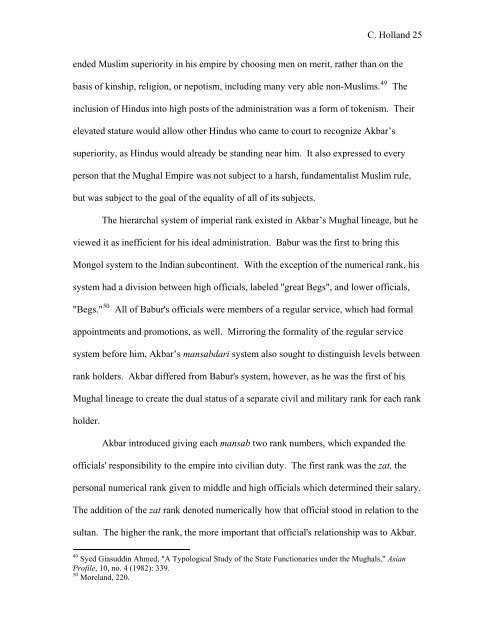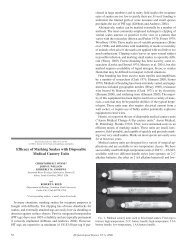Akbar and the Mughal State - University of Georgia
Akbar and the Mughal State - University of Georgia
Akbar and the Mughal State - University of Georgia
You also want an ePaper? Increase the reach of your titles
YUMPU automatically turns print PDFs into web optimized ePapers that Google loves.
C. Holl<strong>and</strong> 25<br />
ended Muslim superiority in his empire by choosing men on merit, ra<strong>the</strong>r than on <strong>the</strong><br />
basis <strong>of</strong> kinship, religion, or nepotism, including many very able non-Muslims. 49 The<br />
inclusion <strong>of</strong> Hindus into high posts <strong>of</strong> <strong>the</strong> administration was a form <strong>of</strong> tokenism. Their<br />
elevated stature would allow o<strong>the</strong>r Hindus who came to court to recognize <strong>Akbar</strong>’s<br />
superiority, as Hindus would already be st<strong>and</strong>ing near him. It also expressed to every<br />
person that <strong>the</strong> <strong>Mughal</strong> Empire was not subject to a harsh, fundamentalist Muslim rule,<br />
but was subject to <strong>the</strong> goal <strong>of</strong> <strong>the</strong> equality <strong>of</strong> all <strong>of</strong> its subjects.<br />
The hierarchal system <strong>of</strong> imperial rank existed in <strong>Akbar</strong>’s <strong>Mughal</strong> lineage, but he<br />
viewed it as inefficient for his ideal administration. Babur was <strong>the</strong> first to bring this<br />
Mongol system to <strong>the</strong> Indian subcontinent. With <strong>the</strong> exception <strong>of</strong> <strong>the</strong> numerical rank, his<br />
system had a division between high <strong>of</strong>ficials, labeled "great Begs", <strong>and</strong> lower <strong>of</strong>ficials,<br />
"Begs." 50 All <strong>of</strong> Babur's <strong>of</strong>ficials were members <strong>of</strong> a regular service, which had formal<br />
appointments <strong>and</strong> promotions, as well. Mirroring <strong>the</strong> formality <strong>of</strong> <strong>the</strong> regular service<br />
system before him, <strong>Akbar</strong>’s mansabdari system also sought to distinguish levels between<br />
rank holders. <strong>Akbar</strong> differed from Babur's system, however, as he was <strong>the</strong> first <strong>of</strong> his<br />
<strong>Mughal</strong> lineage to create <strong>the</strong> dual status <strong>of</strong> a separate civil <strong>and</strong> military rank for each rank<br />
holder.<br />
<strong>Akbar</strong> introduced giving each mansab two rank numbers, which exp<strong>and</strong>ed <strong>the</strong><br />
<strong>of</strong>ficials' responsibility to <strong>the</strong> empire into civilian duty. The first rank was <strong>the</strong> zat, <strong>the</strong><br />
personal numerical rank given to middle <strong>and</strong> high <strong>of</strong>ficials which determined <strong>the</strong>ir salary.<br />
The addition <strong>of</strong> <strong>the</strong> zat rank denoted numerically how that <strong>of</strong>ficial stood in relation to <strong>the</strong><br />
sultan. The higher <strong>the</strong> rank, <strong>the</strong> more important that <strong>of</strong>ficial's relationship was to <strong>Akbar</strong>.<br />
49<br />
Syed Giasuddin Ahmed, "A Typological Study <strong>of</strong> <strong>the</strong> <strong>State</strong> Functionaries under <strong>the</strong> <strong>Mughal</strong>s," Asian<br />
Pr<strong>of</strong>ile, 10, no. 4 (1982): 339.<br />
50<br />
Morel<strong>and</strong>, 220.





